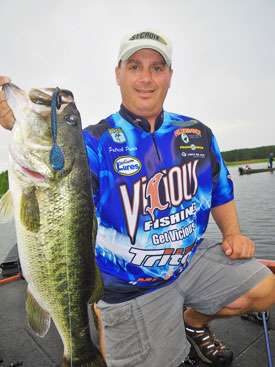
Flipping may be the best way to bag a heavy stringer during the hot months, but it takes more than a heavy rod and a big weight. Florida pro Patrick Pierce knows lots of the intricacies of flipping you may be overlooking.
On paper, flipping and pitching sound simple. Get the funky "casts" down, find some grass, and start filling the livewell. But as Jimmy Houston once said, "If bass fishing were that easy, it wouldn't be a sport, it would be a habit."
Patrick Pierce's relationship with flipping, however, can be classified as an addiction rather than just a habit.
Combing the grass
Bass are like people in some regard. They're apex predators, don't like to be out in the sun when they don't have to be, have some places they're more comfortable than others and like it when their food is brought to them. Grass offers a bass all of this. It's the La-Z-Boy of the lake.
When you're in a lake inundated with grass, it can be difficult to identify bass-holding grass from bass-free grass. Pierce says to look for ambush points that have current flowing by them.
"Points catching wind seem to be key spots to flip if there is no natural current in your lake," he says. "The bass will sit in there and wait for something to wash by. It's a reaction bite."
If there is no current at all, he looks for irregularities in the grass such as an indentation, a thin spot, a place where two types of grass mix or bait flipping on top. Once he has found fishy-looking grass, it's time to pattern the fish.
"I always start at the outer edge to 12 inches in, then I go to the middle portion, then I'll flip a foot or two away from the bank," he says. "I try to make myself make three pitches before I move the boat."
All in the details
Flipping is fishing's close quarter combat. You are sneaking up on fish and leveraging the element of surprise against them, like a ninja.
"These fish you're trying to catch are only 15 or 20 feet away from the boat, so you need to be very quiet. Shut the big motor down far away from where you plan to fish, and keep the trolling motor as low as possible while fishing," he says. "Your bait also needs to be presented subtly as well. Sometimes the grass is really thick and you have to toss the bait in the air, but only do it as high as you need."
If you don't need to flop it in some slop, try to stop the bait an inch or two above the surface so it slips in without a splash. This takes some practice, but when mastered it is stealthier and can be applied to other baits like jigs and spinnerbaits.
Since he mostly flips soft plastics, Pierce says there are guidelines to follow concerning weight and your bait.
"If you've got sparse grass, or if the day is overcast, you can go with a bigger bait, because they get comfortable under there. When the grass is really matted up, bulkier baits can't penetrate the grass, so you need a slimmer-profile bait and larger weight," he says. "I go with the smallest weight I can get away with, too."
Pierce prefers a snelled 4/0 straight-shank hook. He says that a snelled straight-shank hook gives the angler more leverage and will almost always snag the fish in the upper lip. To keep the bait from slipping down the shank, he puts a dab of super glue on the head.
Pierce's flipping outfit of choice is a 7-foot, 11-inch St. Croix Big Gulp flippin' stick and 65-pound-test Vicious braid. Pierce likes the Big Gulp for its parabolic bend that affords him a split second longer to react so the fish does not feel tension that could lead him to spit the bait.
Pierce flips Net Bait's Paca Craw when the grass is matted and Net Bait's Paddle Tail worm when it is sparse or thinly matted. Imagine a stickworm with a silver dollar on the back and you've got the paddle tail. The Paca Craw has a hollow body for positive hooksets or rattles.
"When that big floppy tail lands in front of them, they can't help but eat it," he says of the Paddle Tail.
After the cast
Immediately after Pierce's bait hits the water, he stops its fall with his thumb.
"Until you've patterned the fish, you don't know where they're holding. You need to stop it just under the roof of the bass' house in case they're suspending, which is usually the case if the bottom is soft. Stopping it gives them a second to grab it before it goes down.
"You don't want to let it free fall to the bottom, because they can't grab it if it shoots past them. Keep a little tension on the spool to control the fall," he says. "If it turns out they are suspending near the top and you quit getting bites, you need to shake the mat."
Shaking the mat is dropping the bait under the mat, then pulling it to the underside and lifting it gently so the mat moves. This gives the appearance of a bait fish trying to escape through the vegetation.
If the fish are on the bottom, Pierce lowers the bait and lets it sit for three or four seconds before he picks it up and makes another flip.
"If you don't get bit within 15 or 20 minutes, you need to change your bait, color, or presentation. If they're there, they'll eat.
"Flipping is the most exciting way to fish. You're always in the strike zone, close to the fish, and when you get a bite, it's a 30 second tug-of-war," he says.




